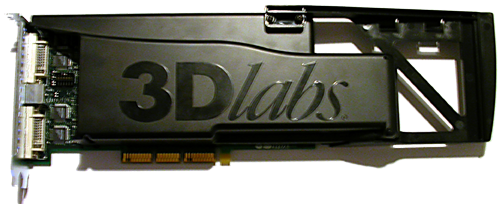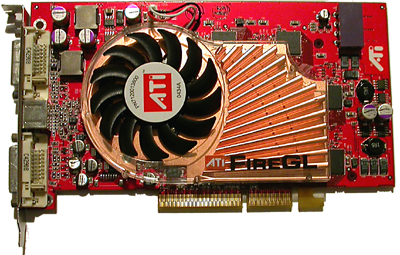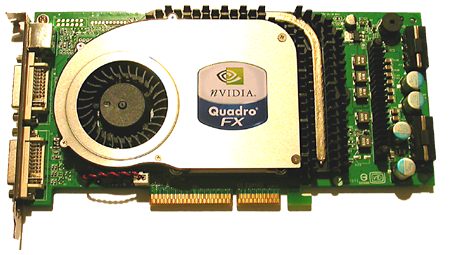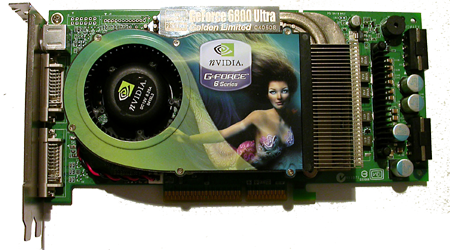Workstation Graphics: AGP Cross Section 2004
by Derek Wilson on December 23, 2004 4:14 PM EST- Posted in
- GPUs
The Cards
We are focusing on 3 workstation cards today, and we will also be using 2 ultra high end desktop cards for reference. Here's the lineup of workstation parts that we will be looking at:| AGP Workstation Graphics Contenders | |||
| 3Dlabs Wildcat Realizm 200 | ATI FireGL X3-256 | NVIDIA Quadro FX 4000 | |
| Street Price | ~$860 | ~$875 | ~$1600 |
| Memory Size/Type | 512MB GDDR3 | 256MB GDDR3 | 256MB GDDR3 |
| Memory Bus | 256bit | 256bit | 256bit |
| Memory Clock | 500MHz | 450MHz | 500MHz |
| Core Clock | ? | 490 | 375 |
| Vertex Pipes | 4 | 6 (4 Full DX9) | 6 |
| Vertex Processing | 36-bit | 32-bit | 32-bit |
| Pixel Pipes | 12 | 12 | 16 |
| Pixel Processing | 32-bit / 16-bit storage | 24-bit | 32-bit / 16-bit selectable |
| Shader Model Support | VS 2.0 / PS 3.0 | SM 2.0 | SM 3.0 |
| 2x Dual-Link DVI | Yes | Yes | Yes |
| Stereo 3D | Yes | Yes | Yes |
| Genlock/Framelock | Multiview Upgrade | No | SDI version |
Clearly, the competition is well matched, with the exception of price. Of course, we don't know the core clock speed of the 3Dlabs part, but recalling the architectural description, looking at the head-to-head numbers and noting the prices of the parts, the tests should prove to be very interesting. Street prices came from looking at what Google and pricewatch had to offer. Here are the images of the workstation cards that we'll be testing:

3Dlabs' Wildcat Realizm 200 High End AGP Workstation card

ATI's FireGL X3-256 AGP Workstation Card

NVIDIA's Quadro FX 4000 High End AGP Workstation Card
The two consumer level cards against which we chose to compare our workstation parts were the most powerful parts that we could dig up in our lab from the ATI and NVIDIA camp.
It used to be that NVIDIA sold the cheapest workstation components by simply overclocking their desktop part and enabling hardware point and line antialiasing. We can see with the most recent Quadro part that their philosophy has changed quite a bit. Unfortunately, we aren't able to force the GeForce 6 Series to hardware accelerate antialiased wireframe drawing, but the 6800 Ultra Golden Limited (is that name a descriptor or what?) that we received from Prolink does a very solid job of pushing data through. It has a 25MHz higher core clock than the 6800 Ultra and it sports 1.15 GHz data rate GDDR3 memory.

Prolink's GeForce 6800 Ultra Golden Limited
From the ATI camp, we employed the ever faithful HIS. Always the best choice in ATI overclocking, HIS shipped us one of their IceQ II series of parts. We had planned to do a roundup, but unfortunately, they were the only vendor to actually ship us a Radeon X800 XT Platinum Edition part. Luckily, the once out-of-work X800 XTPE has recently been re-adopted by ATI in the form of the X850 XT. They may be "different silicon", but to the end user, they are the same part. And so, we're testing with the HIS Radeon X800 XT PE IceQ II both on its legacy as a failed launch product, and as a glimpse at how the X850 XT will run workstation applications (provided ATI actually does get their cards out in January as said they would). Either way, this HIS part is the highest performing ATI based solution that we could dig up to compete with our workstation components.

HIS' Radeon X800 XT PE IceQ II










25 Comments
View All Comments
Jeanlou - Thursday, December 1, 2005 - link
Hello,I just bumped into AnandTech Video Card Tests, and I'm really impressed !
As a Belgian Vision Systems Integration Consultant (since 1979), I'm very interrested about the ability to compare these 3 cards (Realizm 200 vs FireGL X3 256 vs NVIDIA Quatro FX 4000).
I just had a bad experience with the Realizm 200 (!)
On a ASUS NCCH-DL motherboard, Dual Xeon 2.8GHz, 2GB DDR 400, Seagate SCSI Ultra 320 HDD, 2 EIZO monitors (Monitor N°1= L985EX at 1600x1200 px), (Monitopr N°2= L565 at 1280x1024 px), Windows XP Pro SP2 x32bit partition C:\ 16GB, Windows XP Pro x64bit edition partition D:\ 16GB, plus Extended partions (2 logical E:\ and F:\). All NTFS.
Using the main monitor for images analyses (quality control) and the slave monitor for tools, I was unable to have a stable image at 1600 by 1200 pixels. While the Wildcat4 - 7110, or even the VP990 Pro have a very stable screen at maximum resolution. But the 7110 and the VP990 Pro don't have drivers for Window XP x64bit.
Tried everything, latest BIOS, latest drive for ChipSet...
Even 3Dlabs was unable to give me the necessary support and do not answer anymore !
As soon I reduced the resolution from the main monitor to 1280 by 1024, was everything stable, but that's not what I want, I need the maximum resolution on the main monitor.
The specs from 3Dlabs resolution table is giving 3840 by 2400 pixels maximum!
I send it back, and I'm looking for an other card.
I wonder if the FireGL X3 256 will do the job ?
We also use an other monitor from EIZO (S2410W) with 1920 by 1200 pixels !
What are exactly the several resolutions possible with the FireGL X3 256 using 2 monitors ? I cannot find it on the specs.
Any comment will be appreciated,
Best regards,
Jean
kaissa - Sunday, February 20, 2005 - link
Excellent article. I hope that you make workstation graphic card comparision a regular article. How about an article on workstation notebooks? Thanks a lot.laverdir - Thursday, December 30, 2004 - link
dear derek wilson,could you tell us how much is the performance
difference between numa and uma in general
on this tests..
and it would be great if you could post maya
related results for guadro 4k with numa enabled..
seasonal greetings
RedNight - Tuesday, December 28, 2004 - link
This is the best workstation graphics card review I have read in ages. Not only does it present the positive and negatives of each the principal cards in question, it presents them in relationship to high end mainsteam cards and thereby helps many, including myself, understand the real differences in performance. Also, by inovatingly including AutoCAD and Gaming Tests one gets a clear indication of when the workstation cards are necessary and when they would be a waste of money. ThanksDerekWilson - Monday, December 27, 2004 - link
Dubb,Thanks for letting us know about that one :-) We'll have to have a nice long talk with NV's workstation team about what exactly is going on there. They very strongly gave us the idea that the featureset wasn't present on geforce cards.
#19, NUMA was disabled because most people running a workstation with 4 or fewer GB of RAM on a 32 machine will not be running with the pae kernel installed. We wanted to test with a setup most people would be running under the circumstances. We will test NUMA capabilities in the future.
#20,
When we test workstation CPU performance or system performance, POVRay will be a possible inclusion. Thanks for the suggestion.
Derek Wilson
mbhame - Sunday, December 26, 2004 - link
Please include POVRay benchies in Workstation tests.Myrandex - Saturday, December 25, 2004 - link
I wonder why NUMA was fully supported but yet disabled. Maybe instabilities or something.Dubb - Friday, December 24, 2004 - link
http://newbietech.net/eng/qtoq/index.phphttp://forums.guru3d.com/showthread.php?s=2347485b...
Dubb - Friday, December 24, 2004 - link
uhhh.. my softquadro'd 5900 ultra begs to differ. as would all the 6800 > qfx4000 mods being done by people on guru3d's rivatuner forum.I thought you guys knew that just because nvida says something doesn't mean it's true?
they must consider "physically different sillicon" to be "we moved a resistor or two"...
DerekWilson - Friday, December 24, 2004 - link
By high end features, I wasn't talking about texturing or prgrammatic vertex or fragment shading (which is highend in the consumer space).I was rather talking about hardware support for: AA lines and points, overlay plane support, two-sided lighting (fixed function path), logic operations, fast pixel read-back speeds, and dual 10-bit 400MHz RAMDACs and 2 dual-link DVI-I connectors supporting 3840x2400 on a single display (the IBM T221 comes to mind).
There are other features, but these are key. In products like Maya and 3D Studio, not having overlay plane support creates an absolutely noticable performance hit. It really does depend on how you push the cards. We do prefer the in application benchmarks to SPECveiwperf. Even the SPECapc tests can give a better feel for where things will fall -- because the entire system is a factor rather than just the gfx card and CPU.
#14, Dubb -- I hate to be the one to tell you this -- GeForce and Quadro are physically different silicon now (NV40 and NV40GL). AFAIK, ever since GF4/Quadro4, it has been impossible to softquadro an nvidia card. The Quadro team uses the GeForce as it's base core, but then adds on workstation class features.